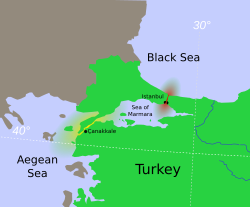
Back أزمة جنق قلعة Arabic Çanaqqala böhranı AZ Chanakkrise German Incidento de Çanak EO Affaire de Tchanak French משבר צ'נקלה HE Crisi di Çanakkale Italian チャナク危機 Japanese Criza Çanakkale Romanian Çanakkale Krizi Turkish
This article includes a list of general references, but it lacks sufficient corresponding inline citations. (October 2020) |
| Chanak crisis | |||||||
|---|---|---|---|---|---|---|---|
| Part of the Anglo-Turkish War (1918–1923) | |||||||
 British pilots of 203 Squadron look on as ground personnel service the engine of one of the squadron's Nieuport Nightjar fighters whilst detached to Gallipoli, Turkey, in 1922 | |||||||
| |||||||
| Belligerents | |||||||
|
| |||||||
| Commanders and leaders | |||||||
| Units involved | |||||||
|
| Occupation forces | ||||||
| Strength | |||||||
|
|
All Allied forces in Istanbul and Çanakkale[1] Total: c. 51,300 soldiers (411 machine guns, 57 artillery pieces) (French and Italian forces withdrew as soon as the ultimatum was delivered.) | ||||||
| Casualties and losses | |||||||
| None | None | ||||||
The Chanak crisis (Turkish: Çanakkale Krizi), also called the Chanak affair and the Chanak incident, was a war scare in September 1922 between the United Kingdom and the Government of the Grand National Assembly in Turkey. Chanak refers to Çanakkale, a city on the Anatolian side of the Dardanelles Strait. The crisis was caused by Turkish efforts to push the Greek armies out of Turkey and restore Turkish rule in the Allied-occupied territories, primarily in Constantinople (now Istanbul) and Eastern Thrace. Turkish troops marched against British and French positions in the Dardanelles neutral zone. For a time, war between Britain and Turkey seemed possible, but Canada refused to agree as did France and Italy. British public opinion did not want a war. The British military did not either, and the top general on the scene, Sir Charles Harington, refused to relay an ultimatum to the Turks because he counted on a negotiated settlement. The Conservatives in Britain's coalition government refused to follow Liberal Prime Minister David Lloyd George, who with Winston Churchill was calling for war.[2]
The crisis quickly ended when Turkey, having overwhelmed the Greeks, agreed to a negotiated settlement that gave it the territory it wanted. Lloyd George's mishandling of the crisis contributed to his downfall via the Carlton Club meeting. The crisis raised the issue of who decided on war for the British Empire, and was Canada's first assertion of diplomatic independence from London. Historian Robert Blake says the Chanak crisis led to Arthur Balfour's definition of Britain and the dominions as "autonomous Communities within the British Empire, equal in status, in no way subordinate one to another in any aspect of the domestic or internal affairs, though united by a common allegiance to the Crown, and freely associated as members of the British Commonwealth of Nations". In 1931 the UK Parliament enacted Balfour's formula into law through the Statute of Westminster 1931.[3]

- ^ Zekeriya Türkmen, (2002), İstanbul'un işgali ve İşgal Dönemindeki Uygulamalar (13 Kasım 1918 – 16 Mart 1920), Atatürk Araştırma Merkezi Dergisi, XVIII (53): pages 338–339. (in Turkish)
- ^ A. J. P. Taylor (1965). English History 1914–1945. Oxford University Press. pp. 190–92. ISBN 9780191501296.
- ^ Robert Blake (2013). The Decline of Power, 1915–1964. Faber & Faber. p. 68. ISBN 9780571298259.